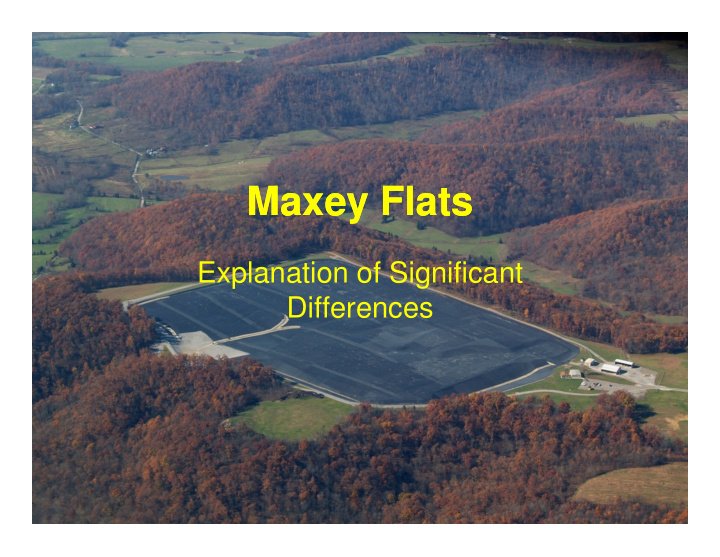



Maxey Flats Maxey Flats Explanation of Significant Explanation of Significant Differences
Record of Decision • A Record of Decision was signed in September 1991. • The ROD required – the installation of an interim cap (and periodic replacement), (and periodic replacement), – maintenance and monitoring for natural stabilization, – when stable, construction of a final RCRA cap, and – monitoring in perpetuity.
Post ROD Changes Post-ROD changes fit into one of the three following categories: • Nonsignificant or Minor Changes - The change will not have a significant impact on the scope, performance or cost of the remedy. • Significant Changes – The change generally involve a change to a • Significant Changes – The change generally involve a change to a component of a remedy that does not fundamentally alter the overall cleanup approach. • Fundamental Changes – The change involves an appreciable change or changes in the scope, performance, and/or cost or may be a number of significant changes that together have the effect of a fundamentalchange. An example of a fundamental change is one that results in a reconsideration of the overall waste management approach selected in the original ROD.
The components of the selected remedy in the ROD include: 1. Excavation of additional on-site disposal trenches for disposal of site debris and solidified leachate; 2. Demolition and on-site disposal of site structures; 3. Extraction, solidification, and on-site disposal of approximately three million gallons of trench leachate; 4. Installation of an initial cap consisting of clay and a synthetic liner; 5. Re-contouring of capped disposal area to enhance management of surface water run on and runoff; 6. Installation of a ground water flow barrier, if necessary; 7. 7. Installation of an infiltration monitoring system to continuously verify remedy Installation of an infiltration monitoring system to continuously verify remedy performance and detect the accumulation of leachate in disposal trenches; 8. Monitoring of ground water, surface water, air, selected environmental indicators, and rates of subsidence; 9. Procurement of a buffer zone adjacent to the existing site property boundary, estimated to range from 200 to 400 acres, for the purposes of preventing deforestation of the hill slopes or other activities which would accelerate hill slope erosion and affect the integrity of the selected remedy, and providing frequent and unrestricted access to areas adjacent to the site to allow monitoring; 10. Installation of a multi-layer engineered soil cap with synthetic liner after natural subsidence process is complete; 11. Five-year reviews to evaluate the protectiveness of the remedy and to ensure the selected remedy is achieving the necessary remedial action objectives; and 12. Institutional controls to restrict the use of the MFDS and to ensure monitoring and maintenance in perpetuity.
Continuous Level Monitoring • On July 14, 2005, the KDEP submitted a Technical change to switch from continuous level monitoring to manual level monitoring. • KDEP reported problems with the current automated systems operation and accuracy. systems operation and accuracy. • Only 52 of the 83 sump level systems collected accurate levels for the April-June quarter download. • KDEP report that it is more difficult to obtain the levels with the current automated system as opposed to collecting manually.
Ground Water Flow Barrier • One component of the remedy was to determine if a ground water barrier was needed to reduce the horizontal flow of groundwater into the trenches. • Water levels in 83 sumps were monitored from 2003-2013. • The CD required that a statistical analysis be performed to evaluate the need for a hydraulic barrier before the private and federal PRP’s responsibilities at the site are discharged in 2013. • The statistical analysis demonstrates that water levels are not increasing significantly in sumps and no groundwater barrier is needed.
Remedial Design Changes to Cap 1. Use geonet instead of crushed rock for drainage layer. 2. Use 60-mil geomembrane instead of 80-mil geomembrane. geomembrane. 3. Use geosynthetic clay liner (GCL) instead of 2-ft compacted clay. 4. To increase structural stability add geogrid to cap.
Recommend
More recommend